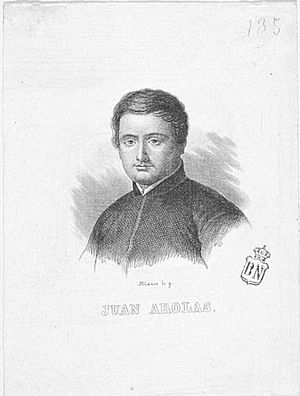Juan Arolas facts for kids
Juan Arolas (born in 1805, died in 1849) was a famous Spanish poet and writer. He is known for his interesting poems and stories.
Contents
About Juan Arolas
Juan Arolas was born in 1805. His parents were successful traders. He grew up in the city of Valencia, Spain. There, he went to school with a religious group called the Piarists.
In 1819, he joined the Piarist order in a town called Peralta de la Sal. Some people say his family made him join. Others believe he truly wanted to be part of the order. While he was there, he met a girl and fell in love. We don't know her name today.
Juan Arolas studied philosophy in Zaragoza. He also studied theology in Valencia. From 1825 to 1842, he worked as a professor. He taught at the Colegio Andresiano in Valencia.
He also joined literary groups. These were meetings where writers and thinkers shared ideas. He met other Piarist members like Vicente Boix and Pascual Perez Rodriguez.
Arolas was a strong supporter of freedom and new ideas. In 1833, he and Perez started a newspaper. It was called the Diario Mercantil. This newspaper supported freedom and Queen Isabel II.
Juan Arolas loved reading romantic stories. He especially liked writers from England and France. He wrote many poems that were like exciting stories. These often had an "oriental" or Middle Eastern feel.
He was a very popular poet across Spain. He wrote a lot of poetry. He did not leave the Piarist order. Perhaps he was worried about how he would make a living. He faced health challenges from 1842 until his death in 1849.
His Writings and Poetry
Juan Arolas wrote a lot of poetry very easily. He sometimes copied or used ideas from other writers. He liked to make his poems sound fancy. However, he didn't always focus on the deep meaning of his poems.
His poetry is not as well-known as some other Spanish Romantic writers. But he still created important works. Some of his main collections of poems include:
- Chivalrous and Oriental Poetry (1840)
- Pastoral and Amorous Poems (1843)
- Religious, Chivalrous, Amorous, and Oriental (1860)
His last collection shows the different types of poems he wrote. He also wrote many funny and clever poems.
Love Poems
His love poems mixed old styles with new romantic ideas. Some of his poems were influenced by ancient Roman love poems. Others were more passionate and romantic. A famous love poem is "A una bella" (To a Beautiful Woman). Its main line is "sé más feliz que yo" (be happier than I am).
Story Poems
Arolas also wrote narrative poems. These were like stories in verse. Some well-known ones include "Leyenda tártara" (Tartar Legend), "los amores de Semíramis" (The Loves of Semiramis), and "Granada." These poems often had a strong sense of place.
Chivalrous Poems
His chivalrous poems were about knights and medieval times. Most of these stories were set in Spain. He got ideas from different historical books. These poems showed the influence of other Spanish writers like Rivas and José Zorrilla.
La sílfide del acueducto
One of his most interesting works is La sílfide del acueducto (The Sylph of the Aqueduct). It was published in Valencia in 1837. This long poem has about 4,300 lines. He dedicated it to a girl named Leonor from Peralta.
The poem tells a story that seems to be based on his own life. It is about two lovers, Hormesinda and Ricardo. Ricardo is forced by his father to join a monastery. Hormesinda manages to find him. They share their love, but the abbot (the head of the monastery) finds out. Hormesinda is harmed, and Ricardo is put in prison. He later dies there.
However, the story has a happy ending for their souls. Their spirits go to the Elysian Fields. This is a beautiful place in Greek mythology. There, they can finally be together and enjoy the love they couldn't have on Earth. This poem also shares Arolas's ideas about freedom. It shows his protest against strict religious rules.
Religious Poems
Juan Arolas also wrote religious poems. He was inspired by the French poet Lamartine and the Bible. These poems often talked about God's power and greatness. They also explored human mistakes and thanklessness towards God. Many of these poems were about stories from the Bible or events in the life of Jesus.
See also
 In Spanish: Juan Arolas Bonet para niños
In Spanish: Juan Arolas Bonet para niños
- Romanticism in Spanish literature
- Romanticism: General view of the movement.
- Spanish literature: Evolution of Spanish literature.


